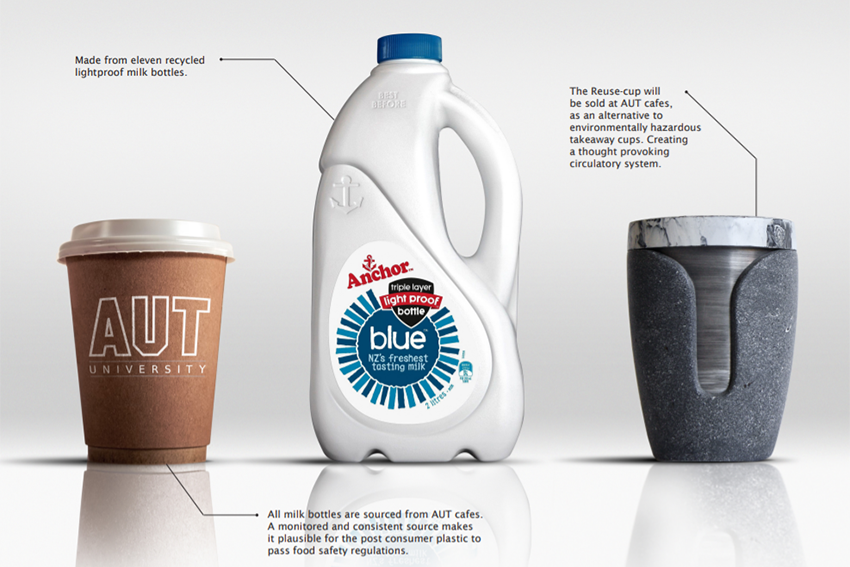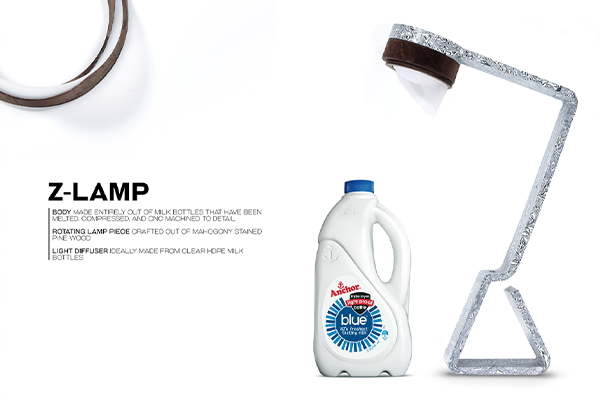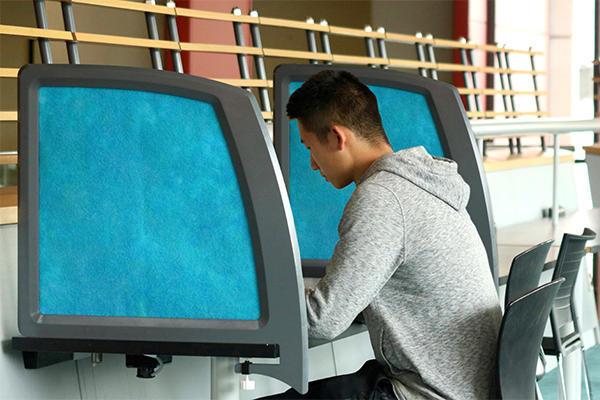Teaching sustainability in design

Sixty thousand light-proof milk bottles a year, or approximately 2400 kg of HDPE plastic, shipped off-campus. For most, this is a recycling nightmare at best. For Industrial Design students at AUT, these bottles were a valuable resource to be reimagined in a circular economy challenge.
Lecturer Anke Nienhuis says the milk bottles are a valuable resource that is currently being shipped off-campus. With a group of third-year Industrial Design students, she looked for ways this resource could be reimagined into new products to be used on campus. The results were a selection of high-quality items made from the milk bottle plastic, all applicable in various areas of campus life.
Nienhuis says AUT’s City Campus uses as many as 60,000 milk bottles every year, in normal, non-lockdown times. "AUT uses milk delivered in triple-layer light-proof plastic bottles – that's a layer of black plastic sandwiched in between two layers of white plastic. The volume of bottles used on campus provided us with a valuable resource. The students were challenged to develop a way for these bottles to be recycled at AUT, and reimagined into functional products to be used at the university. This allows us to create a small scale circular economy, rather than to send our recyclables away to be processed and hopefully turned into a new product.
"We collaborated with the Estates team and staff from AUT's cafes to get empty and cleaned bottles delivered to our studio. Engineering students also worked on the project, on designing and building machinery to process the milk bottle plastic. The machinery made for the project includes a plastic shredder and a press that can make sheet material out of the shredded milk bottles once a still to be built heating element is completed.
The mix of black and white coloured plastic in the light-proof bottles makes for the distinctive pattern or marble effect when these bottles are melted.
Students were encouraged to experiment with the milk bottle plastic extensively and to design products, keeping the properties and qualities of the material in mind. Some of our third-year students worked with the material in quite innovative ways to create feasible and desirable products."
Anton Elliot embraced the distinctive black and white contrast of the melted plastic to create attractive hanging divider screens designed to create privacy in the shared spaces of our city campus.
Jake Clayton stayed close to the source of the identified waste, designing a reusable and portable coffee cup, made out of the discarded milk bottles to be sold and used at the AUT cafes and beyond. The cup has a stainless steel inner but is otherwise entirely made from the milk bottle plastic.
Several students made furniture, stools and tables, out of the sheet material, but one student, Corban Strickland, designed a study lamp to be used in the AUT library. The lamp can also hold and charge a cell phone, very practical for studying students.
The most experimental project was Kynan Robinson's. Kynan researched what products might be needed by AUT students or staff and heard several people mention noise levels and distractions in the library. He created an innovative way to make felt out of the HDPE plastic, then turning this felt into desk dividers, to be used when studying at the library, with excellent acoustic properties, as well as helping to shield the students off visually. The outside frame of the dividers, as well as the acoustic material, are made out of the milk bottle plastic.
"The student feedback about this project was fantastic," says Nienhuis. "They felt proud of their often quite innovative outcomes and empowered and more confident that they can make a difference."
In the next stage, the project team plans to build a heating element to heat the shredded plastic before it goes into the press.
"Our overall department motto is 'Good design for a better world'," says Nienhuis. "Every year we run projects on 'design for sustainability', including projects that look at the minimisation of waste, and projects with 'the value and reuse of waste materials' as their central theme.
The project forms part of undergrad and postgrad teaching in the School of Art and Design’s Industrial Design department, giving students a hands-on learning experience and a sense of empowerment.

